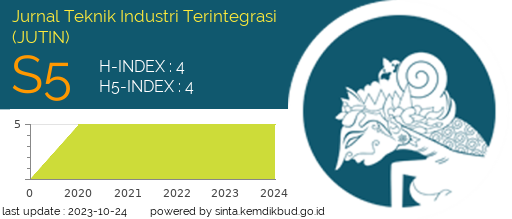Evaluasi Simpang Tiga Tak Bersinyal pada Simpang Tiga Ketapang Cepu
DOI:
https://doi.org/10.31004/jutin.v7i1.24139Abstract
The objectives of this study are as follows: To determine the volume and capacity of the Ketapang Cepu three-stroke intersection. To find out the performance of the Ketapang Cepu intersection that has not been signaled. The researcher's research method is a method with a quantitative approach. The data is in the form of the type of vehicle volume crossing the intersection and traffic volume. Data analysis techniques used to analyze the results of this study using the method of Indonesian Road Capacity Guidelines 2014. The method of analyzing this research data is as follows: Analyzing peak times, namely analyzing survey results. Peak time analysis per 1 hour was conducted, which was analyzed with the rules of the Indonesian Road Capacity Guidelines (PKJI 2014). Conclusion From the results of the calculation above, the intersection capacity is 2950.7 skr / hour, the largest traffic volume is 2373.6 skr / hour, the chance of queuing that occurs 26% - 51%. In PKJI 2014, the delay of all intersections is included in the good category if it is in the range of 5-15 seconds. Based on the data above, the performance of Simpang Tiga Ketapang Cepu is still good (there is no congestion).Downloads
Published
2024-01-19
How to Cite
Saputra, I. H., & Sari , I. R. . (2024). Evaluasi Simpang Tiga Tak Bersinyal pada Simpang Tiga Ketapang Cepu. Jurnal Teknik Industri Terintegrasi (JUTIN), 7(1), 90–100. https://doi.org/10.31004/jutin.v7i1.24139
Issue
Section
Articles of Research
License
Copyright (c) 2024 Ichwan Hadi Saputra, Indah Ratna Sari

This work is licensed under a Creative Commons Attribution-ShareAlike 4.0 International License.





